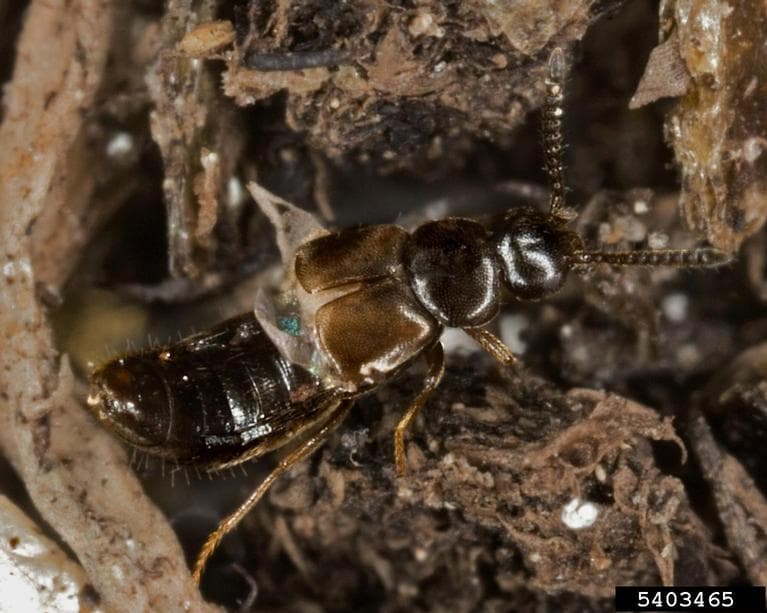Summary
The European earwig has a dark and relatively uniform body color with yellowish shoulders, legs and pincers. They range in size from 12-24 mm long. They have flat smooth elongated bodies and may be winged or wingless. Winged earwigs have two sets of wings, a short hardened forewing and a soft membranous hindwing. They have chewing mouthparts, bead-like antennae and 2 pincers at the rear of the body. Males have longer and curved pincers whereas females have straight pincers.
Females will lay 1-2 clutches of 20-80 eggs from May to October, which hatch over 2-3 weeks. Nymphs go through 5 instars before becoming adults, and generally resemble adults but are smaller, lighter in color and lack wings. Adult and nymphs peak around October/November depending on region and year. European earwigs often congregate together and exist in communal situations whereas many native earwigs are solitary.
The European earwig is an omnivore and is extremely polyphagous, eating a range of both living and dead plant and animal material. The European earwig feed on leaves and stems, and on germinating seed. In Australia, broadacre winter crops are most vulnerable to feeding damage during establishment.
While commonly regarded as a crop pest in Australia, overseas the European earwig is often considered a beneficial natural enemy of agricultural pests, such as aphids and caterpillars, particularly in fruit orchards and vineyards.
Chemical Management
No registered chemical sprays are available for controlling European earwigs in broadacre crops. Broad-spectrum insecticides used for bare-earth and foliar applications may not have an impact on European earwigs as they tend to seek shelter during the day.
Insecticides are registered for use around the exterior of buildings and structures, of which earwigs have been known to spread from and into crops.
Growers often purchase canola seed that is pre-coated with an insecticide dressing. Laboratory trials conducted in controlled environments have shown high mortality rates of European earwigs when they feed on young canola plants grown from seed treated with fipronil.
Insecticidal sprays are registered for European earwigs in horticultural crops including grapes and stonefruit.
Baits are also registered for use in these crops and are more effective than most spray applications. For situations in deciduous crops with a known earwig problem, a bait application during a rainless period in late winter before the breeding cycle commences is a strategic use of bait application.
Even when earwigs are feeding within a canopy, baits can be effective because European earwigs have a strong association with the ground, such as to lay eggs.
Biological Management
There are no known natural enemies which can effectively control the European earwig in Australia.
Vertebrates such as birds and lizards will feed on earwigs, and European earwigs are also cannibalistic, however this is unlikely to provide sufficient population reduction.
Cultural Management
Cultural control practices, such as minimizing stubble retention and reducing available refuges, are likely the most effective long-term strategy for managing earwig populations. Burning has proven successful in reducing populations in certain cases.
Trapping can be an effective method to reduce earwig numbers. Various trap designs can be used, but it is important to provide dark hiding areas that earwigs naturally seek out for daytime shelter. Rolled corrugated cardboard or crumpled newspapers can be highly effective trapping materials.

